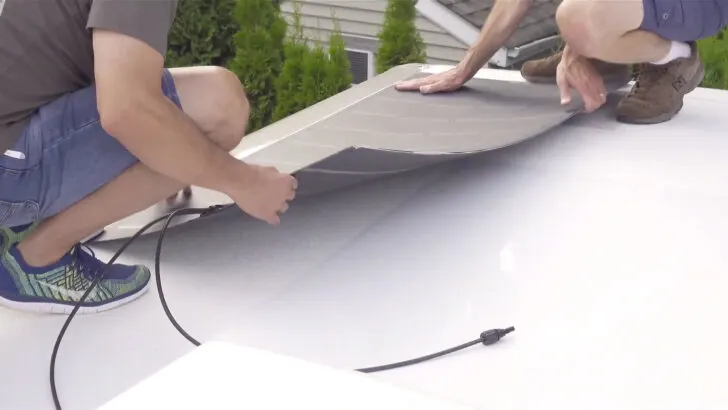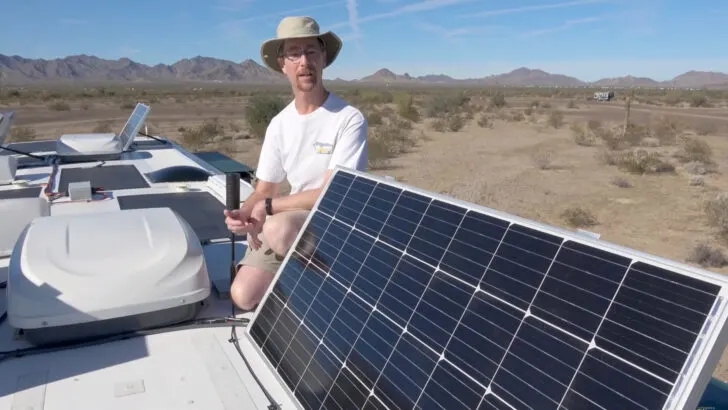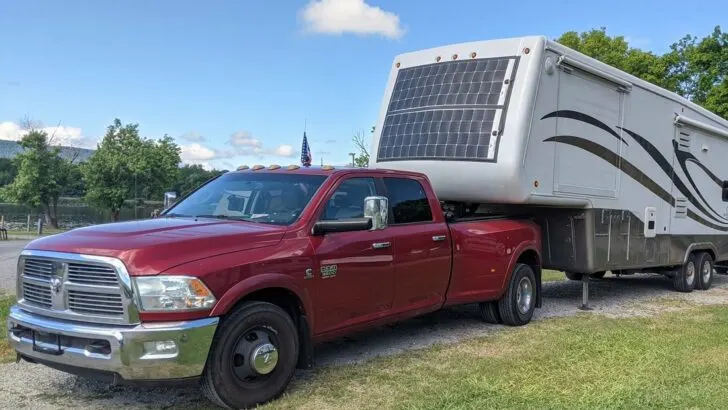We recently published a post about flexible solar panels, and in that post, we noted the advantages and disadvantages flexible panels pose. But how do flexible panels stack up against rigid panels? Is one type better than the other? Can you combine the two types of solar panels on a single RV? We’ll answer all of those questions and more in today’s post on flexible solar panels vs. rigid solar panels.
- 1) How Does a Solar Panel Work?
- 2) What’s the Difference Between Flexible Solar Panels and Rigid Solar Panels?
- 3) What Are the Advantages of Rigid Solar Panels?
- 4) What Are the Advantages of Flexible Solar Panels?
- 5) Flexible Solar Panels vs Rigid: Which Is Better for an RV?
- 6) Can You Combine Flexible and Rigid Solar Panels?
How Does a Solar Panel Work?
On Earth, there’s no greater source of energy than the sun. Solar panels capture the sun’s energy, enabling us to turn it into electricity to power our RVs, homes, cars, etc.
Solar panels are made up of strings of solar cells that convert the sun’s light into electricity. When sunlight hits a solar cell, particles of energy called photons are converted into electrons which pass through the cells of the solar panel and are converted into 12V DC (direct current) electricity that can be stored.

John, explaining how we harness the awesome power of the sun with our combination of tilted rigid solar panels and flexible panels.
What exactly does that mean for RVers like us? If you’ve got a solar panel or two on the roof of your RV, what happens is that sunlight hits the solar panel, and the solar panel provides energy to charge the battery/batteries in your rig. But you can’t connect solar panels directly to your RV’s battery(ies) for a variety of reasons.
So, between the solar panels and your batteries there sits a charge controller. It ensures that your panels can operate at a voltage that works for them, while ensuring the proper charging voltage (and charge profile) is supplied to your battery(ies). When your batteries need replenishing, the charge controller allows the current to flow fully, recharging the batteries. And when the battery is full, the charge controller acts as a barrier to prevent power from flowing FROM the battery back to the panels.
Everyone who has a solar panel of any kind MUST have a charge controller.
One more thing…
Some of the features of our RVs can use (12V) DC electricity, while others require 120V AC (alternating current) power. In order to turn DC power from your battery into AC power usable by certain appliances, your RV requires an inverter. DC power is supplied to the inverter by your RV’s battery(ies), and the inverter converts it to AC power for use by such things as your household power outlets, hairdryer, microwave, or coffee maker.
Now let’s get back to those solar panels…
What’s the Difference Between Flexible Solar Panels and Rigid Solar Panels?
Flexible solar panels and rigid solar panels have the same job to do but they come to the table a bit differently.
Flexible solar panels are thin, light, and slightly bendable (flexible), while rigid solar panels are encased in glass (and, most often, have a metal frame).

Flexible solar panels are thin, light, and slightly bendable, and are able to be laid directly on a surface, even if it’s curved.
Both do the job described above, but their performances vary due to their differences.
Let’s take a look at the advantages of both.
What Are the Advantages of Rigid Solar Panels?
Rigid solar panels have a number of advantages, but they’re not the perfect solution for every application. Here’s where rigid solar panels shine ☀️:
More Durable/Longer Lifespan
They tend to be more durable and have a longer lifespan than flexible solar panels do. Though the technology of flexible solar panels is improving rapidly and this difference may be nearly imperceptible in the near future, the fact remains that at present, a glass-encased solar panel has more durability overall than a flexible solar panel.
Greater Efficiency
While the efficiency of flexible solar panels is rapidly improving as well, rigid solar panels do offer more efficiency than flexible panels in general, especially if they’re tiltable (flexible panels cannot be tiltable, and in this way, rigid panels come out ahead in the battle between flexible solar panels vs rigid).
And that efficiency benefit can translate to a smaller footprint – for the same wattage output, a rigid panel will take up less square footage on your roof than a flexible panel.
In the end, rigid solar panels have an edge over flexible panels in the efficiency category.

The ability to tilt a rigid solar panel is a distinct advantage as it increases the efficiency of the panel based on positioning. The ability to tilt our rigid panels has increased the efficiency of these panels by 40-50%!
Less Expensive to Buy
Rigid panels remain less expensive to purchase than flexible panels. However, you need very little in the way of supplies to mount flexible panels (no hardware, for example), and as flexible panels have become more popular and production has ramped up, their cost is coming down as well. Still, in general, it’s far less expensive to purchase rigid panels.
Less Tendency to Overheat
The heat that’s accumulates in flexible panels that sit directly on the roof is greater than that experienced by rigid panels whose construction and mounting allow for airflow around them. Technology has advanced here as well, and there are ways to mount flexible panels so that airflow is present beneath them (though those techniques somewhat defeat the advantage of a peel-and-stick installation for most flexible panels). But in general, a panel that sits directly on the roof will be exposed to more heat, which reduces their efficiency and power output, while decreasing their expected lifespan.
What Are the Advantages of Flexible Solar Panels?
Flexible panels also have a number of advantages, particularly in certain applications.
Lightweight/Thin
First, they’re lightweight and thin, giving them a clear edge in the discussion of flexible solar panels vs rigid. This is helpful in a couple of different ways.
First, heavy things are a nemesis for RVers – we like things that don’t increase the weight we’re carrying around.
Second, the nature of thin flexible panels is that they’re – well – flexible! They can adjust to the contour of a curved roof or even to the front cap of a 5th wheel. They’re far more adaptable than rigid panels are.
And, because they’re so light, they’re significantly easier to handle when getting them up onto your RV’s roof (or wherever you’re installing them).

We showed you this photo in a previous post, but we have to showcase it again, giving mad props to our friends Tom & Caitlin Morton (Mortons on the Move) for their ingenuity in installing flexible solar panels on the cap of their 5th wheel.
More Portable
Flexible panels are more portable than rigid panels are. If you want to use a rigid solar panel as a portable panel, you’ve got to find a place to store the panels while you’re traveling. They’re also heavy and awkward to move over and over again.
But flexible panels can easily slide into any bay for storage, and many flexible panels are made into portable panels that are folded into sections. This allows them to be folded and stored much more easily, which is especially great for owners of smaller rigs.
Easier to Mount
Flexible panels are very simple to mount (many come ready to install… just peel off the backing on the adhesive layer on the back and stick them in place). They can be mounted on nearly any surface using a heavy-duty VHB tape or Eternabond, or even industrial strength Velcro. No hardware is needed, and you don’t need to drill multiple holes into the roof of your RV. (That alone is worth a prize.)
Flexible Solar Panels vs Rigid: Which Is Better for an RV?
As usual, the answer to this question really depends on the particular application.
Flexible panels are best for curved roofs or caps, and they’re also best for anyone needing to keep the weight of the solar system at a minimum.
However, rigid panels are easier on the budget, are likely to last longer before needing to be replaced, and tend to have a higher output, especially if they’re tiltable.
In our experience with our system, in many conditions the difference between the output from our rigid panels -vs- our flexible ones is negligible (27-28A output from the flexible array while the rigids are putting out 30A). But when the sun is high, the temperatures are up, and there’s not a lot of wind? Well, the heat build-up in the flexible panels definitely reduces their output compared to the rigid panels (in that situation, the flexible panels have been as low as 22-23A, while the rigid panels remain pinned at 30A).
That difference may not sound like a lot, but multiply that by the number of hours of sun and the lost power begins to add up.
Can You Combine Flexible and Rigid Solar Panels?
You absolutely can, and we do! As we noted at the beginning of this post, flexible and rigid solar panels do the same job – they just go about it a little differently.
Here’s John to explain in detail:
Geek Out with Us Every Week
Join our newsletter to learn about all things RV-related. Every week we offer free tips, tricks, product reviews, and more to our online community of RVers. So, whether this is your first time on the road or you’re a seasoned expert, we’d love for you to geek out with us!


Billy
Wednesday 14th of September 2022
Interesting and informative; thank you!
Ken
Saturday 11th of December 2021
????????